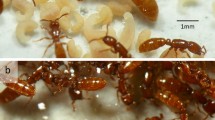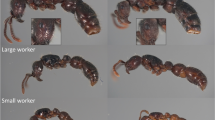Abstract
In ants, winged queens that are specialized for independent colony foundation can be replaced by wingless reproductives better adapted for colony fission. We studied this shift in reproductive strategy by comparing two Mystrium species from Madagascar using morphometry, allometry and dissections. Mystrium rogeri has a single dealate queen in each colony with a larger thorax than workers and similar mandibles that allow these queens to hunt during non-claustral foundation. In contrast, Mystrium ‘red’ lacks winged queens and half of the female adults belong to a wingless ‘intermorph’ caste smaller and allometrically distinct from the workers. Intermorphs have functional ovaries and spermatheca while those of workers are degenerate. Intermorphs care for brood and a few mate and reproduce making them an all-purpose caste that takes charge of both work and reproduction. However, their mandibles are reduced and inappropriate for hunting centipedes, unlike the workers’ mandibles. This together with their small thorax disallow them to perform independent colony foundation, and colonies reproduce by fission. M. rogeri workers have mandibles polymorphic in size and shape, which allow for all tasks from brood care to hunting. In M. ‘red’, colonial investment in reproduction has shifted from producing expensive winged queens to more numerous helpers. M. ‘red’ intermorphs are the first case of reproductives smaller than workers in ants and illustrate their potential to diversify their caste system for better colonial economy.




Similar content being viewed by others
References
Billen J (1982) Ovariole development in workers of Formica sanguinea Latr. (Hymenoptera: Formicidae). Insectes Soc 29:86–94
Brown MJF, Bonhoeffer S (2003) On the evolution of claustral colony founding in ants. Evol Ecol Res 305–313
Fairbairn DJ (1997) Allometry for sexual size dimorphism: pattern and process in the coevolution of body size in males and females. Annu Rev Ecol Syst 28:659–687
Fisher BL (1997) Biogeography and ecology of the ant fauna of Madagascar (Hymenoptera: Formicidae). J Nat Hist 31:269–302
Gobin B, Ito F, Peeters C, Billen J (2006) Queen–worker differences in spermatheca reservoir of phylogenetically basal ants. Cell Tissue Res 326:169–178
Gotwald WH Jr (1995) Army ants: the biology of social predation. Cornell University Press, Ithaca, New York
Gronenberg W, Hölldobler B, Alpert GD (1998) Jaws that snap: control of mandible movements in the ant Mystrium. J Insect Physiol 44:241–253
Harrison RG (1980) Dispersal polymorphisms in insects. Annu Rev Ecol Syst 11:95–118
Haskins CP, Haskins EF (1951) Note on the method of colony foundation of the ponerine ant Amblyopone australis Erichson. Am Midl Nat 45:432–445
Heinze J (1998) Intercastes, intermorphs, and ergatoid queens: who is who in ant reproduction? Insectes Soc 45:113–124
Heinze J, Buschinger A (1989) Queen polymorphism in Leptothorax sp. A: its genetic and ecological background (Hymenoptera: Formicidae). Insectes Soc 36:139–155
Heinze J, Hölldobler B (1995) Thelytokous parthenogenesis and dominance hierarchies in the ponerine ant, Platythyrea punctata. Naturwissenschaften 82:40–41
Hölldobler B, Wilson EO (1990) The ants. Harvard University Press, Cambridge, Massachusetts
Kaspari M, O’Donnell S (2003) High rates of army ant raids in the Neotropics and implications for ant colony and community structure. Evol Ecol Res 5:933–939
Lévieux J (1972) Comportement d’alimentation et relations entre les individus chez une fourmi primitive, Amblyopone pluto Gotwald et Lévieux. Comptes rendu hedomadaire Séance Acadamie des Sciences, Paris 275:483–485
Myles TG, Nutting WL (1988) Termite eusocial evolution: a re-examination of Bartz’s hypothesis and assumptions. Q Rev Biol 63:1–23
Ohkawara K, Ito F, Higashi S (1993) Production and reproductive function of intercastes in Myrmecina graminicola nipponica colonies (Hymenoptera: Formicidae). Insectes Soc 40:1–10
Pamilo P (1991) Evolution of colony characteristics in social insects. I. Sex allocation. Am Nat 137:83–107
Passera L, Keller L (1990) Loss of mating flight and shift in the pattern of carbohydrate storage in sexuals of ants (Hymenoptera; Formicidae). J Comp Physiol B 160:207–211
Peeters C (1991) Ergatoid queens and intercastes in ants: two distinct adult forms which look morphologically intermediate between workers and winged queens. Insectes Soc 38:1–15
Peeters C (1997) Morphologically ‘primitive’ ants: comparative review of social characters, and the importance of queen–worker dimorphism. In: Choe JC, Crespi BJ (eds) The evolution of social behavior in insects and arachnids. Cambridge University Press, Cambridge, pp372–391
Peeters C, Ito F (2001) Colony dispersal and the evolution of queen morphology in social Hymenoptera. Annu Rev Entomol 46:601–630
Peeters C, Liebig J, Hölldobler B (2000) Sexual reproduction by both queens and workers in the ponerine ant Harpegnathos saltator. Insectes Soc 47:325–332
Roff DA (1990) The evolution of flightlessness in insects. Ecol Monogr 60:389–421
Ward PS (1983) Genetic relatedness and colony organization in a species complex of ponerine ants. I. Genotypic and phenotypic composition of colonies. Behav Ecol Sociobiol 12:285–299
Warton DI, Weber NC (2002) Common slope tests for bivariate errors-in-variables models. Biom J 44:161–174
Wheeler WM (1922) Ants of the American Museum Congo expedition. A contribution to the myrmecology of Africa. I. On the distribution of the ants of the Ethiopian and Malagasy regions. Bull Am Mus Nat Hist 45:13–37
Wheeler DE, Martínez T (1995) Storage proteins in ants (Hymenoptera:Formicidae). Comp Biochem Physiol B 112:15–19
Acknowledgements
We thank M. Beekman, F. Ito and D. Wheeler for the helpful comments on the manuscript. F. Ito provided unpublished data about M. camillae. We are grateful to Brian Fisher’s team in Madagascar for the field assistance and the warm welcome. This work was supported in part by the National Geographic Society grant n° 7617-04, National Science Foundation grant n° DEB-0344731 to B.L. Fisher and P.S. Ward and Laboratoire d’Ecologie CNRS UMR 7625. Research and export permits were issued by the Association Nationale pour la Gestion des Aires Protégées, République de Madagascar.
Author information
Authors and Affiliations
Corresponding author
Rights and permissions
About this article
Cite this article
Molet, M., Peeters, C. & Fisher, B.L. Winged queens replaced by reproductives smaller than workers in Mystrium ants. Naturwissenschaften 94, 280–287 (2007). https://doi.org/10.1007/s00114-006-0190-2
Received:
Revised:
Accepted:
Published:
Issue Date:
DOI: https://doi.org/10.1007/s00114-006-0190-2




